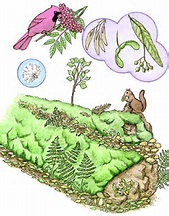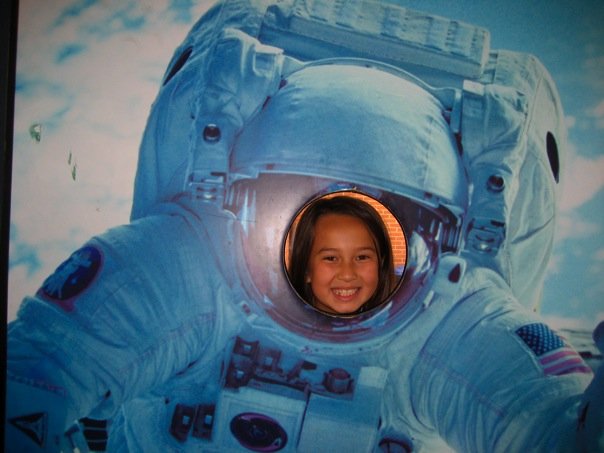I started after school science teaching when my brother was in grade school to amuse him and keep him learning. We went to Catholic School so there was essentially not much science.
I lived in Alexandria, Va . and I would take him to the Smithsonian to learn things. There were all of the Smithsonian buildings and projects to learn about. It was not so easy as now, finding all kinds of things, programs and resources for him. No technology then except in the museum. But what was in the museum was like magic.

Students explore visualizations of the oil spill.
After school then was anything he wanted to learn about. We built things and made things and constructed a boat inside a bottle. We waded streams and raised animals and went on excursions to aquariums and zoos. Talk about maker. My dad was a Shop teacher, that is electrical, bricklaying, and woodworking shop. You know we made things!!! Lots of people did in the CTE space.
When I became a teacher there was no much interest in science. In the schools I taught in reading and math were the main focus. In urban schools the joy of learning was over shadowed by drudgery.
Holidays and pull out classes wrecked the schedule so we did not get to teach much science, history or other subjects. I think science was reserved for the “elite” or that people did not think that anyone but boys should do science. I did not like basal readers and the booklets, and tablets and worksheets that went with them. I was a reader and I loved science. I remember being told that science was not fun.
I fled teaching and went to Europe. Teaching there I had choices to make and I could be innovative
Starting Hands On Science
Eventually ,I made my way to Arlington Schools. Innovation was being supported. CUSEEME was a project i did.It was technology at the National Science Foundation.

I began to take NASA classes and learn about space. The support was posters, professional development and mentoring. I found that children liked, .. well loved science. NASA was free, I just had to donate my time and interest. We called STEM then SMET.
AAAS had a class which I took that gave me all , or most of the resources to teach hands on science with and that was a very supportive way of letting teachers change the way science was taught. ( NOT reading out of a book).
Science and the new technologies were promoted by the Dept. of Education, Frank Withrow and Jenelle Leonard. I was an instant follower.

Dr. Phoebe Knipling ,introduced the kids and I to the Outdoor Lab. I did not have much choice. It took a couple of lessons, a few courses and outdoor experiences before I felt accomplished. Parents and children were supportive. And there were places to take great field trips in our area.
The Smithsonian Environmental Research Center (SERC) is dedicated to providing high quality educational programs that incorporate SERC research with hands-on and inquiry-based learning. Their programs are led by SERC staff and highly-trained volunteers, and emphasize the practices of science – one of the major components of the Next Generation Science Standards (NGSS). While our main activities focus on grades K-12, we also offer programs for organized groups and teacher professional development. At the time the field trip there was so exciting that I had as many parents as children going on the trip, and also liking the followup. Eat -a Crab Lab.
She was the supervisor, so I learned
.
We took classes on birding, weeds and wildflowers and learned to explore areas in streams for living things. This was getting to be fun. It was school science but the learning, professional development and courses were in my after school space. The field trips were a part of the offering of the school. There were courses through the school systems offerings. CEU credits were offered and sometimes resource materials.
Classes spent the night at the Outdoor Lab.

Moving along with Science.
The Smithsonian had resources for pixellation, and information on Mars that was a part of science education. Powers of Ten, that was a great exhibit at the Air and Space museum. The Smithsonian had an exhibit on Living in Space, with plants, moon rocks, ideas to tell /share about living in space and information on the Astronauts.
Marsville, Mars City Alpha , Hubble Institute initiatives, these were really not allowed in the curriculum space. There were ways to work it in. I taught it after school and in project based learning. In a school space, there was a county wide initiative on Wednesdays at the Career Center. We did not call it the Maker Movement. We called it Children’s Choice and we created a set of lessons that kids could sign up for. We also created a set of lessons that were on Saturday from 9:00 to 1:00.
Cooking, Animal Husbandry, Pets, Face painting, Computer Construction, Sewing 101 and Woodworking, Theater Arts, Coding. small projects like that. There was math. Teachers from the country volunteered their time to teach. We thought we replace the time that parents and grandparents used to give to students.
Our students learned cooking with a real chef. They cooked and made pizza which they ate and carried home. I don’t remember everything they made but they had projects like donut making, making cupcakes.

We did astronomy and space science education and every project that came our way through NASA. There is this one…https://universe.nasa.gov/afterschool/
I like it that the kids, and parents innovate in the program. It is also true that they build a telescope. It is an awesome program. It was a STEAM project.
Here is a different math program.https://www.smartskies.nasa.gov/flyby/index.html
I liked the math in Fly By Math and here is a simulator.
| Five Distance-Rate-Time Problems for Grades 5-9 FlyBy Math™ consists of five Air Traffic Control (ATC) Problems that address the safe separation of two planes.In each problem, students:
Student Materials
Teacher Materials
Extension In addition to the FlyBy Math hands-on experiment and print workbooks, students can now run and solve each FlyBy Math problem electronically on the Math In PlaneView Simulator. The simulator uses the highest level of the 6 math approaches offered by FlyBy Math: graphing a system of linear equations. The simulator helps students connect the movement of planes and the associated linear equations and distance vs. time graphs. To access the simulator and the accompanying classroom materials, use the link on the FlyBy Math website. |
| https://atcviztool.nasa.gov/
|
The Audubon Society, let me learn weather as it was taught then. We learned quadrat studies too.
There were grants to write within the county, the state and nationally, there was funding for Wednesday classes at the Career Center for students from all over the county.
We made up a list of interesting things for them to choose from. We imagined that back in the day grandmothers and uncles share with the kids.We met Cosmonauts, we met geographers, we did the Jason Projects, Earthwatch , and the National Geographic inspired us. When the projects began they were not so expensive as they are now.
Now STEM is on everyone’s mind and is a big business. Teachers can compete with some programs, but there are schools that have not done but rudimentary participation in after school science.
Some communities give support to STEM in Boys and Girls Clubs. There are dedicated universities that deliver programs for 4H in a state. https://4-h.org/parents/stem-agriculture/
I did a brief stint with the MadScience.org
The MadScience is an afterschool initiative that is global. It is about an hour of performance science with a take home tool or toy. I enjoyed teaching it, but as an experienced teacher there was a penalty to pay for my experience so I was passed up because their lessons don’t require academics, they teach a set program and provide all of the resources. There is no magic in that program for being a seasoned educator,cheaper to hire people as contractors. I think it is a good, after school program.


